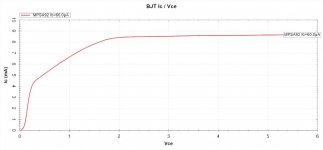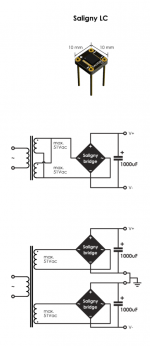Mark,
That’s very generous offer, but rather pointless when I don’t know how you got to your graphs.
Incomparable tests will give incomparable results.
If you don’t want the give the details of the test setup, I’m just fine.
Hans
That’s very generous offer, but rather pointless when I don’t know how you got to your graphs.
Incomparable tests will give incomparable results.
If you don’t want the give the details of the test setup, I’m just fine.
Hans
Measure them yourself, according to your beliefs about what should be measured and how the measurements should be made. Since you appear to be interested in the Early effect, I recommend you start with that. Measure Early effect at different VCEs and different ICEs. Find out whether Early voltage is a strong function, a weak function, or a nonexistent function of bias point. SPICE only has one fitting parameter for Early voltage, called "VAF", so (if the modeling gang at UC Berkeley is right), there is a negligible amount of variation with bias point. See whether your measurements agree!
Maybe you will discover that MPSA92 is an excellent transistor at low VCE, with a spectacularly high Early voltage (much higher than the ZTX958!!) when the measurements are correctly done your way. Try it and find out.
Maybe you will discover that MPSA92 is an excellent transistor at low VCE, with a spectacularly high Early voltage (much higher than the ZTX958!!) when the measurements are correctly done your way. Try it and find out.
Dear Mark,
It looks like you don’t trust your own results.
So let’s call it a day.
Let me wish you all the best for 2021.
Hans
It looks like you don’t trust your own results.
So let’s call it a day.
Let me wish you all the best for 2021.
Hans
It looks like you don’t trust your own results.
No it doesn't, Hans. It looks like you don't want to believe his results but won't do anything practical to counter them.
Happy New Year to you.
John
Nice to see that Mark has so many followers.
Looking at the graphs both transistors have circa 18k output impedance at 8 mA collector current.
That’s quite low so it justifies the simple question how it was measured.
And I’m more than willing to counter that measurement, but I can only repeat what I said before: when we don’t use the same setup, results will be incomparable and thus be a waste of time.
Hans
Looking at the graphs both transistors have circa 18k output impedance at 8 mA collector current.
That’s quite low so it justifies the simple question how it was measured.
And I’m more than willing to counter that measurement, but I can only repeat what I said before: when we don’t use the same setup, results will be incomparable and thus be a waste of time.
Hans
I do trust Mark's results and have confirmed them myself.
May I comment that the output impedance in your measurement is way higher than Mark’s.
Hans
I projected both MPSA92 measurements on top of each other after having given them exactly the same scale.
Result are now much better to compare.
Output impedance that seemed much higher in Stormsonic's smaller image now turns out to be the same as in Mark's version.
So now coming from two independent sources, I'm convinced.
I still don't see why a simple question how a measurement was done could create so much fuzz.
Hans
Result are now much better to compare.
Output impedance that seemed much higher in Stormsonic's smaller image now turns out to be the same as in Mark's version.
So now coming from two independent sources, I'm convinced.
I still don't see why a simple question how a measurement was done could create so much fuzz.
Hans
Attachments
Hans, I would be happy to send you some devices so you can measure them yourself. Then you will know with perfect certainty, how the measurements were done. You will also have great confidence that the measurements were done at exactly the conditions you prefer: temperature, bias point, ambient light level, faraday cage yes/no, battery power or AC-DC power, and so forth. I don't see how a simple offer of assistance could create so much fuzz.
Hello.
I need to get 24v positive from the regulator, so please let me know if my calculation is correct:
D5 change from LM329 to LM4040-10
24V - 10V = 14v
14/10 = "Z"= 1.4
"Z" multiplied by R7 or R14 value = R6/R13 value
for
R7/R14 = 1K
R6/R13 = 1.4K
D2(pos) and D7(neg): change the zener from 6.8v to a 12volt
change to 35v caps
I need to get 24v positive from the regulator, so please let me know if my calculation is correct:
D5 change from LM329 to LM4040-10
24V - 10V = 14v
14/10 = "Z"= 1.4
"Z" multiplied by R7 or R14 value = R6/R13 value
for
R7/R14 = 1K
R6/R13 = 1.4K
D2(pos) and D7(neg): change the zener from 6.8v to a 12volt
change to 35v caps
Jan, Thanks for checking.
My project will use multiple 24v(positive only) SuperRegs: Do I need a separate pre-regulator for EACH +24v Superreg?
My project will use multiple 24v(positive only) SuperRegs: Do I need a separate pre-regulator for EACH +24v Superreg?
You don't need any pre-regulator in my view.
I know they are in fashion and they can lead to a measurable difference, but I am not convinced they lead to a change in sound.
But nothing stops you from doing what you feel is best of course.
Jan
I know they are in fashion and they can lead to a measurable difference, but I am not convinced they lead to a change in sound.
But nothing stops you from doing what you feel is best of course.
Jan
Should a R + Cap input filter, or a cap multiplier be more effective than a pre-regulator?
LTSPice sims seem to show that. PSRR is the more affected, no so much noise or impedance. But there's a high prize in lost volts to pay.
One super-regulator I need is +/-30v, and 30v + 30v transformer, which is not cheap and easy to find, would be barely enough if you use a pre-regulator. I would need to jump to 40 + 40 or 50 +50, and things really get expensive and large.
LTSPice sims seem to show that. PSRR is the more affected, no so much noise or impedance. But there's a high prize in lost volts to pay.
One super-regulator I need is +/-30v, and 30v + 30v transformer, which is not cheap and easy to find, would be barely enough if you use a pre-regulator. I would need to jump to 40 + 40 or 50 +50, and things really get expensive and large.
By pre-regulator I was referring to the DC supply that feeds a SuperReg. Would a basic AC To DC Full Wave Bridge Rectifier work best for this?
And will I need a separate DC source for each Positive SuperReg and if so, why? If the DC source provides enough amperage, can it be shared by let's sat 3 positive SuperRegs?
Thanks!
And will I need a separate DC source for each Positive SuperReg and if so, why? If the DC source provides enough amperage, can it be shared by let's sat 3 positive SuperRegs?
Thanks!
You need a DC source as input. A rectified AC with a reservoir cap will do, as long as the ripple is not so large that it dips below the minimum input to the regulator.
For example, if your regulator output is 24V, the input should not drop below about 26V.
If you have rectified voltage of say 30V, the ripple should not dip below 26V
If the input DC has enough capacity, it can feed multiple regulators.
Just to make sure we understand this, a pre-regulator is an actual regulator before the super regulator. If you want to be accurate, a cap multiplier is not a regulator. It's a cap multiplier, there is no feedback regulation provision as in an actual regulator.
Jan
For example, if your regulator output is 24V, the input should not drop below about 26V.
If you have rectified voltage of say 30V, the ripple should not dip below 26V
If the input DC has enough capacity, it can feed multiple regulators.
Just to make sure we understand this, a pre-regulator is an actual regulator before the super regulator. If you want to be accurate, a cap multiplier is not a regulator. It's a cap multiplier, there is no feedback regulation provision as in an actual regulator.
Jan
Last edited:
Just to make sure we understand this, a pre-regulator is an actual regulator before the super regulator. If you want to be accurate, a cap multiplier is not a regulator. It's a cap multiplier, there is no feedback regulation provision as in an actual regulator.
Certainly so. What I was talking about were passive filters, R, C or L, after the full wave bridge that can allow to feed clean DC to the super-regulator.
That was measured on many tests. You can see simulations where the difference between different types of filters change things for the better in the pre-regulator performance. A simple C/R or a Pi filter does wonders, particularly in PSRR.
Carlos, sorry but to be clear: any filtering or preregulation or whatever changes the noise and ripple but it does nothing to the PSRR. PSRR is a property of the circuit that is being fed.
Jan
Jan
- Home
- The diyAudio Store
- Super Regulator


